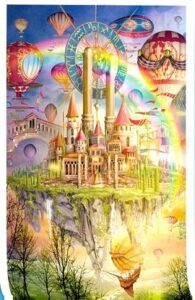When I was growing up, Santa brought my family a new jigsaw puzzle every Christmas. Later in the day, Dad would set up the card table and parents and siblings would draw up chairs and start turning over puzzle pieces. Hours passed with breaks for snacks and the bathroom. Pieces fell into place faster and faster until we were all fighting to grab that last piece and put it in place.
Then we’d sit back and finally see the completed picture on the puzzle.

But in order for us to finish the puzzle in a reasonable amount of time and with our sanity (especially my parents’) intact, we continually referred to the box top with the picture of what the completed puzzle should look like.
Whether you are writing a book, painting a picture or trying to grow your creative business, you want to keep hold of that big picture box top:
- So you know where to start and where to end. When we plan for a trip to Italy, Bob and I know that our flight begins in New York City and ends in Italy. When I write a book, knowing where I want to end my story helps me know where I want to start it, and also some of the things that need to happen between those two points.
- So you know when you get off track. Have you ever picked up a puzzle piece certain you know where it goes—the color is right, the shape seems right—and then you look at the big picture on the box top and discover where it really goes or what goes there instead? If I have a big picture for my story and suddenly the middle is sagging or something just doesn’t feel right, I can go back to the big picture or outline of my novel to figure out where I may be off track.
- So you can deliberately choose alternate routes. Some people, like my dad, put the borders of a puzzle together first. Other people like to put together easy-to-identify objects or people first. Either approach is made easier with that box top picture. Similarly, if Bob and I want to explore off the beaten path while in Italy, we can check a map for alternative routes to our final destination. If I decide to change a scene in my novel, an outline helps me figure out how to get from the new scene back to a pivotal plot point. Because sometimes it’s the detours that bring the best discoveries and the most rewards, as long as we know how to re-adjust our route to get where we want to go.
- So you know time and distance. If the box top says the puzzle has 1000 pieces, then you know that puzzle is going to take a while. If the picture shows a lot of people’s faces or lots of different objects, then the puzzle will go together fairly quickly. If, however, the box top shows a Jackson Pollack painting (yes, we have one of those) with smears of paint and colors in all directions, then this puzzle may take days or even weeks. Same thing with an outline for a story or the steps for a creative project. You can even plan for interruptions and delays.
- It helps keep the pieces from getting lost. Have you ever finished a puzzle only to find that the last piece is missing? Makes you want to tear your hair out, doesn’t it? Especially after one of those 1000-pieces monsters. The same is true for your novel or other creative project. You are less likely to miss an important piece of your work if it is contained by that box top.
How detailed your big picture for your project or work is, is up to you. Some of us are plotters (lots of detail). Others of us are pantsers (working by the seat of our pants). But even pantsers will admit to at least having a beginning, an end and some of the middle in mind when they start writing or creating. Details may be fuzzy, but they have the big picture.
So, where is your big picture box top? And when was the last time you looked at it?
Save